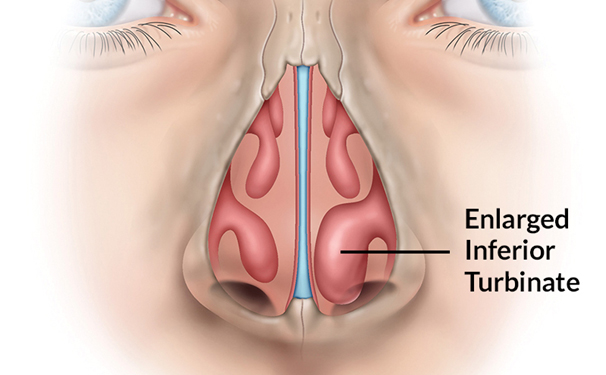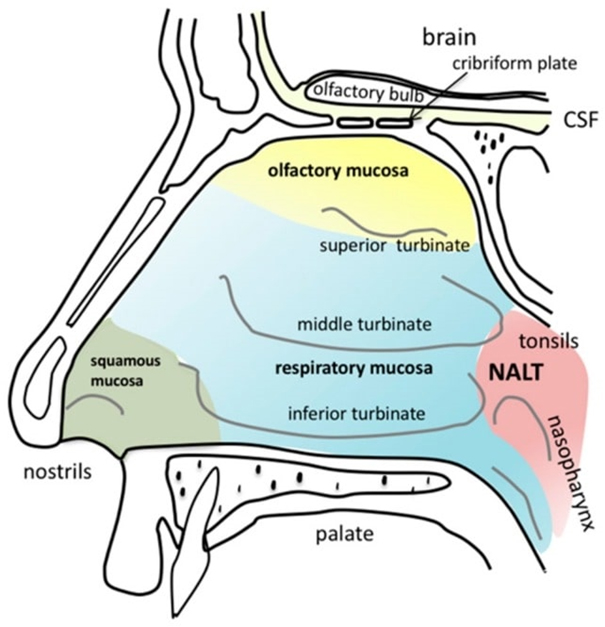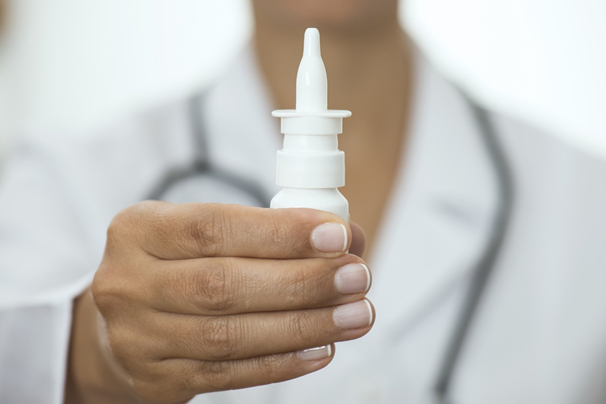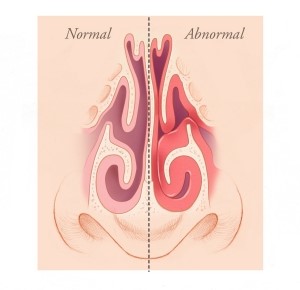Nasal concha surgery, also known as turbinate reduction surgery, is a common procedure aimed at improving nasal airflow by addressing issues related to the nasal turbinates (conchae). Concha Surgery – Chronic nasal congestion or nasal congestion is usually caused by enlargement (hypertrophy) of the lower turbinate. Nasal congestion can disrupt normal breathing, force patients to breathe through the mouth, and often affects their daily activities.
Nasal Concha Surgery: Indications, Procedure, Risks, and Outcomes
Abstract
The turbinates are structures inside the nose that play a critical role in warming, humidifying, and filtering the air we breathe. However, when the turbinates become enlarged, they can cause nasal obstruction, leading to chronic congestion, breathing difficulties, and reduced quality of life. This article provides an in-depth review of nasal concha surgery, including the indications for the procedure, the different surgical techniques, risks and complications, recovery process, and expected outcomes. We will also address frequently asked questions based on recent clinical evidence.
Introduction
Nasal Concha Surgery – What is Hypertrophy?
The nasal turbinates (also called conchae) are structures inside the nasal cavity that help regulate airflow by warming, moistening, and filtering inhaled air. These structures are composed of bone and soft tissue and are located on the lateral walls of the nasal passages. There are three pairs of turbinates: the superior, middle, and inferior turbinates.
In some cases, these turbinates can become enlarged (a condition called turbinate hypertrophy) due to chronic inflammation, allergies, or other factors, leading to nasal obstruction and difficulty breathing through the nose. When conservative treatments such as medications or nasal sprays do not alleviate the symptoms, surgery may be considered.
Nasal concha surgery is a procedure designed to reduce the size of the turbinates and restore proper airflow through the nasal passages. This surgery can greatly improve the quality of life for patients suffering from chronic nasal congestion or other related symptoms.
Indications for Nasal Concha Surgery
Nasal concha surgery is generally recommended when the patient experiences chronic nasal obstruction that significantly affects their quality of life and does not respond to non-surgical treatments. Some common indications for the procedure include:
- Chronic Nasal Congestion:
One of the most common reasons for nasal concha surgery is chronic nasal congestion caused by enlarged turbinates. When the turbinates become swollen, they obstruct airflow, making it difficult to breathe through the nose. This is often exacerbated by allergies, sinus infections, or environmental irritants. - Obstructive Sleep Apnea (OSA):
Enlarged turbinates can contribute to obstructive sleep apnea (OSA), a condition where the airway becomes partially blocked during sleep, leading to breathing pauses, loud snoring, and disturbed sleep. Turbinate reduction surgery can be an adjunct to other procedures (such as septoplasty or uvulopalatopharyngoplasty) in the management of OSA. - Chronic Sinusitis:
Chronic sinusitis or recurrent sinus infections can also be associated with enlarged turbinates. In some cases, turbinate reduction surgery can help improve sinus drainage by opening up the nasal passages and reducing inflammation in the sinuses. - Allergic Rhinitis:
Patients with allergic rhinitis may suffer from nasal congestion due to enlarged turbinates. If medical treatments, such as antihistamines or nasal steroids, do not provide sufficient relief, turbinate reduction surgery may be considered. - Mouth Breathing:
Persistent nasal congestion caused by enlarged turbinates may lead to habitual mouth breathing, which can result in dry mouth, dental issues, and discomfort. Nasal concha surgery can help address this problem by improving airflow through the nose.
The Nasal Concha Surgery Procedure
Nasal concha surgery is typically performed under local or general anesthesia, depending on the patient and the complexity of the surgery. The procedure aims to reduce the size of the turbinates, improving airflow and relieving nasal obstruction. There are several surgical techniques used to perform turbinate reduction, and the choice of technique depends on the patient’s specific needs and the surgeon’s preference.
1. Turbinate Reduction Techniques
- Radiofrequency Ablation:
Radiofrequency ablation (RFA) is a minimally invasive procedure that uses controlled heat to shrink the enlarged turbinate tissue. During the procedure, a special probe is inserted into the turbinate, delivering radiofrequency energy to the tissue. This technique is usually performed in an outpatient setting, and recovery time is relatively short. Radiofrequency ablation is generally used for mild to moderate turbinate enlargement. - Submucosal Resection:
This technique involves removing a portion of the turbinate bone and soft tissue. The surgeon makes a small incision inside the nasal cavity and removes the inner tissue of the turbinate while preserving the outer lining. This is a more invasive procedure compared to radiofrequency ablation and may require general anesthesia. - Turbinate Partial Resection:
Partial resection involves removing a portion of the turbinate to reduce its size. This technique is often used for more severe cases of turbinate hypertrophy. The surgeon may remove part of the turbinate bone, as well as some of the mucosal lining. This procedure is typically performed under general anesthesia. - Laser-Assisted Turbinate Reduction:
Laser-assisted reduction uses a laser to vaporize the enlarged turbinate tissue. It is a minimally invasive technique that can be performed under local anesthesia. The laser helps to shrink the turbinate tissue, improving nasal airflow. However, laser-assisted reduction is less commonly performed than other methods due to concerns about the risk of excessive scarring. - Turbinate Suture or Coblation:
In this technique, sutures or coblation (a process that uses radiofrequency to break down tissue) are used to shrink the turbinate. This is another minimally invasive option with a shorter recovery period compared to traditional resection methods.
Risks and Complications of Nasal Concha Surgery
While nasal concha surgery is generally considered safe, like any surgical procedure, it carries some risks and potential complications. Common risks include:
- Bleeding:
Mild bleeding is common after turbinate reduction surgery, but significant bleeding is rare. Patients may experience some bleeding from the nose in the days following surgery. In most cases, the bleeding can be controlled with nasal packing or other conservative measures. - Infection:
As with any surgery, there is a risk of infection. Infections can cause increased pain, swelling, or fever. If an infection occurs, it may require antibiotic treatment. - Scarring:
Scarring inside the nasal cavity is a potential complication, especially with more invasive surgical techniques such as partial resection or submucosal resection. Scarring can result in further nasal obstruction or a sensation of congestion. - Dryness or Crusting:
After surgery, patients may experience dryness or crusting in the nasal passages, which can lead to discomfort. This is often temporary and can be managed with saline nasal sprays or humidifiers. - Temporary Nasal Congestion:
While the goal of surgery is to improve airflow, patients may experience temporary nasal congestion as the tissues heal. This should improve over time as the swelling reduces. - Persistent Symptoms:
In some cases, the procedure may not provide complete relief from nasal obstruction. If symptoms persist, further treatment or revision surgery may be necessary.
Recovery and Post-Operative Care
The recovery process following nasal concha surgery depends on the surgical technique used, but most patients can expect to return to normal activities within 1-2 weeks. Here are some key aspects of post-operative care:
- Pain Management:
Mild pain or discomfort is common after surgery. Over-the-counter pain relievers such as acetaminophen or ibuprofen are often sufficient to manage pain. Stronger pain medications may be prescribed if necessary. - Nasal Care:
Patients are typically advised to use saline nasal sprays or rinse with saline solution to keep the nasal passages moist and to prevent crusting. It is also recommended to avoid blowing the nose forcefully in the first few days after surgery. - Rest and Avoiding Physical Strain:
Physical activity should be minimized for at least a week following surgery to reduce the risk of bleeding. Resting and avoiding strenuous activities such as heavy lifting or vigorous exercise is crucial for a smooth recovery. - Follow-up Appointments:
A follow-up appointment will be scheduled within a few weeks after surgery to ensure proper healing and to monitor for any complications. This is an important step to ensure that the procedure has been successful.
Outcomes of Nasal Concha Surgery
Nasal concha surgery can provide significant relief for patients with chronic nasal congestion, sleep apnea, or other related conditions. Most patients experience improved airflow through the nose and a reduction in symptoms such as snoring, mouth breathing, and nasal obstruction.
In cases of allergic rhinitis or chronic sinusitis, turbinate reduction surgery can also improve sinus drainage and decrease the frequency of infections. Studies indicate that patients who undergo turbinate reduction surgery report better quality of life, improved sleep, and reduced reliance on medications.
Frequently Asked Questions (FAQs)
1. Is nasal concha surgery painful?
While discomfort is common after the procedure, most patients experience mild pain that can be managed with over-the-counter pain relievers. The pain is usually worst in the first few days and subsides as the swelling goes down.
2. How long does recovery take after turbinate reduction surgery?
Recovery time varies depending on the surgical technique used, but most patients can return to normal activities within 1-2 weeks. It may take up to a few months for full healing.
3. Are there risks of complications after nasal concha surgery?
As with any surgery, there are risks of bleeding, infection, and scarring. However, these complications are rare, and most patients recover without major issues.
4. Can turbinate reduction surgery be done in combination with other procedures?
Yes, turbinate reduction surgery is often performed alongside other procedures, such as septoplasty (for a deviated septum) or sinus surgery, especially in patients with sleep apnea or chronic sinusitis.
Conclusion
Nasal concha surgery is an effective treatment for individuals suffering from chronic nasal obstruction caused by enlarged turbinates. With various surgical techniques available, the procedure can significantly improve nasal airflow and enhance the patient’s overall quality of life. While the risks and complications are minimal, proper post-operative care and follow-up appointments are essential to ensure a successful outcome. For patients who suffer from chronic nasal congestion or other related issues, nasal concha surgery offers a reliable and safe solution.

Nasal Concha Surgery
Since nasal breathing is the normal respiratory tract during sleep, enlarged turbinates and nasal congestion can also contribute to headaches and sleep disorders such as snoring and obstructive sleep apnea.
Diagnosis of Internal Concha Hypertrophy
Usually, a diagnosis of inferior turbinate hypertrophy can be made at your first visit. After taking your history and performing an exam, we will use an endoscope, a small telescope with a light at one end and a lens at the other, to examine the inside of your nose. The MiniCAT Instant CT scan will also show hypertrophy of the inferior turbinate. If there is a finding that requires Nasal Concha Surgery, it will be shared with you.
Turbine Reduction Treatments
There are several medications that can be used to treat symptoms (mostly congestion) caused by inferior turbinate hypertrophy. These include:
- nasal steroid sprays
- nasal antihistamine sprays
- Oral decongestants
- oral steroids

Nasal Concha Surgery
These medications are designed to help reduce swelling (inflammation) and improve nasal breathing.
If medications aren’t enough, we may need to do a simple procedure to reduce the size of your inferior turbinates.
Turbinoplasty Procedure
A simple operating procedure is performed to remove enlarged (hypertrophic) turbinates. A small stick with a suction device is used to remove excess tissue in the inferior turbinate. The procedure takes only a few minutes, is virtually painless, and results in a dramatic improvement in nasal airflow.
This is often the perfect long-term, durable solution to get patients back to enjoying life!
Sometimes, repetitive sessions may be required in turbinate reduction. Swelling may recur, especially in patients with allergic rhinitis, and the procedure may be repeated after 2 years. Since it is a 15-minute procedure performed under local anesthesia, it usually does not burden the patient.
In addition, this procedure is routinely applied in septoplasty (deviation operation) and rhinoplasty when necessary.
What Are Turbines and What Do They Do?
The turbinates are two spongy curved bones that protrude into the nasal passages. They can be found on both sides of the nasal cavity and are separated by the nasal septum. The turbinates are lined with respiratory epithelium, which covers a thick layer of vascular tissue. There are three turbines, named according to their location: the lower, middle, and upper turbines. The inferior turbinate is the largest and most prone to swelling and obstructing airflow.

Nasal Concha Surgery
The turbinates are responsible for directing the airflow within the nasal cavity. The soft tissue covering them is responsible for humidifying, warming and filtering the inhaled air. It is important to humidify the air so as not to damage the olfactory receptors, which are responsible for the recognition of various odors and smells. The epithelial layer is also the first line of immunological defense to trigger a rapid immune response at signs of microbial or chemical irritation.
What Causes Turbinates to Inflate?
Nasal Concha Surgery – Concha hypertrophy may develop in response to various environmental factors and infections. The mucous membranes covering the turbinates contain numerous blood vessels and easily contract or swell in response to a variety of factors. The turbinates may swell due to allergies, chemical or physical irritations, temperature changes, or acute sinus infections. This creates congestion as the airflow through the nose becomes blocked. These are usually temporary conditions and the turbinates return to their normal size and the person’s congestion is relieved.

Nasal Concha Surgery
Persistent inflammation, allergic reactions, and constant exposure to various environmental irritants can cause chronic swelling of the turbinates. This usually occurs in the inferior turbinates and is called turbinate hypertrophy. This makes it difficult for the person to breathe through their nose. Concha hypertrophy is associated with chronic sinus infections and may result from an untreated deviated septum.
Eliminating the factors that cause irritation of the mucous membranes or treating the underlying allergies with nasal steroid sprays can reduce swelling and improve breathing. However, when this swelling is chronic, surgery may be needed to reduce the size of the inferior turbinates.
How Will My Recovery Be After Concha Reduction Surgery?
Your recovery may vary depending on how much tissue your doctor had to remove and whether your turbinate surgery was combined with another sinus opening procedure, such as balloon sinus dilatation. You will receive specific details during your consultations, but here are some general recovery guidelines.
These procedures usually do not remove the bone, so healing is not overly difficult. You will be stuffy for a few days to a week, but your breathing will probably be better by now. Your reduced turbinates will swell and you’ll likely have yellow or bloody crusts for a week or so. You may have bloody discharge for the first 3-5 days, but this depends on the patient. Patients say that the area is uncomfortable, but they do not describe it as painful. You will get extra strong Tylenol and that will be enough. You should avoid aspirin and NSAIDs such as Motrin, Advil, and Aleve as they can cause bleeding. There may be congestion and you may feel like you have a bad cold.
To aid healing, you need to keep the blood pressure on your face to a minimum. Stay calm for the first week and then gradually increase your activity. Within two weeks, you can exercise as you wish. Most patients only require a few days off after turbinate reduction surgery.
Is Concha Reduction Surgery Safe?
This is a safe procedure. Your doctor uses the most minimally invasive methods for these turbinoplasties. Nasal Concha Surgery – There may be some bleeding and bloody discharge after the surgery, but this can be prevented by using nasal saline spray every 2-3 hours. We will provide you with all the instructions on how to take care of your sinuses after this procedure. This is a very successful, safe procedure.

Nasal Concha Surgery
Can You Reduce Swelling in Turbines Without Turbine Reduction Surgery?
Yes, these are first-line treatment for all of our patients. The non-surgical treatments we use are:
- Nasal or oral steroid sprays
- Nasal or oral antihistamines
- Nasal saline sprays or high volume irrigations
- Oral decongestants (not nasal decongestants, as these can usually allow relapse as soon as the drug is discontinued)

Nasal Concha Surgery
Does This Surgery Make Your Nose Look Different?
No, we do not remove the underlying structural support of your nose, bone and cartilage. This procedure simply removes the excess soft tissue of the inferior turbinate. It does not change the shape of the patient’s nose in any way.
You can access related publications from this link.

Nasal Concha Surgery
Türbinatlar: normal ve anormal karşılaştırma

Nasal Concha Surgery Before After